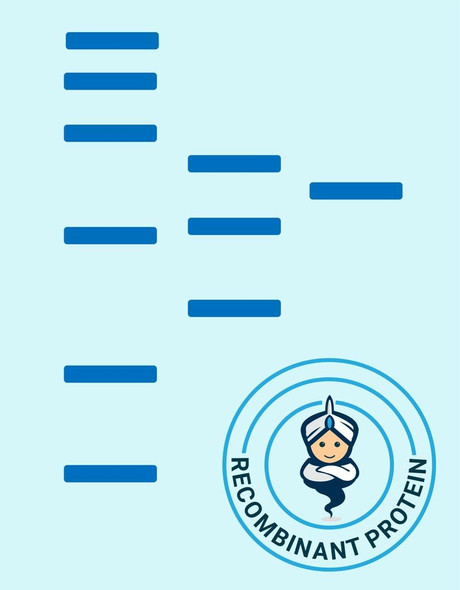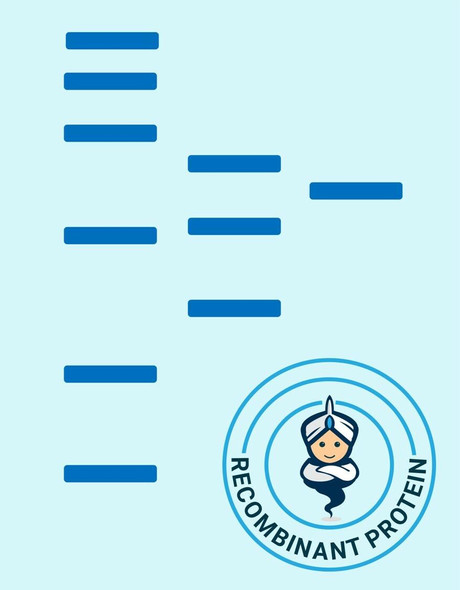Human OGG1 Recombinant Protein (RPPB2056)
- SKU:
- RPPB2056
- Product Type:
- Recombinant Protein
- Species:
- Human
- Uniprot:
- O15527
- Research Area:
- Enzymes
Description
| Product Name: | Human OGG1 Recombinant Protein |
| Product Code: | RPPB2056 |
| Size: | 25µg |
| Species: | Human |
| Target: | OGG1 |
| Synonyms: | HMMH, HOGG1, MUTM, OGH1, AP lyase. |
| Source: | Escherichia Coli |
| Physical Appearance: | Sterile filtered colourless solution. |
| Formulation: | 0.5mg/ml solution containing 20mM Tris-HCl buffer pH-8, 0.1M NaCl and 40% Glycerol. |
| Stability: | Store at 4°C if entire vial will be used within 2-4 weeks.Store, frozen at -20°C for longer periods of time. For long term storage it is recommended to add a carrier protein (0.1% HSA or BSA).Avoid multiple freeze-thaw cycles. |
| Purity: | Greater than 90.0% as determined by SDS-PAGE. |
| Amino Acid Sequence: | MGSSHHHHHH SSGLVPRGSH TGSMPARALL PRRMGHRTLA STPALWASIP CPRSELRLDL VLPSGQSFRW REQSPAHWSG VLADQVWTLT QTEEQLHCTV YRGDKSQASR PTPDELEAVR KYFQLDVTLA QLYHHWGSVD SHFQEVAQKF QGVRLLRQDP IECLFSFICS SNNNIARITG MVERLCQAFG PRLIQLDDVT YHGFPSLQAL AGPEVEAHLR KLGLGYRARY VSASARAILE EQGGLAWLQQ LRESSYEEAH KALCILPGVG TKVADCICLM ALDKPQAVPV DVHMWHIAQRDYSWHPTTSQ AKGPSPQTNK ELGNFFRSLW GPYAGWAQAV LFSADLRQCR HAQEPPAKRRKGSKGPEG |
OGG1 is a DNA glycosylase enzyme which takes part in base excision repair. OGG1 protein is the main enzyme accountable for the excision of 7,8-dihydro-8-oxoguanine (8-oxoG), a mutagenic base byproduct which arises as a result of exposure to reactive oxygen species (ROS). OGG1 shows beta lyase activity that nicks DNA 3'' to the lesion.
OGG1 Recombinant Human produced in E.Coli is a single, non-glycosylated polypeptide chain containing 368 amino acids (1-345 a.a.) and having a molecular mass of 41.2 kDa. The OGG1 is fused to 23 amino acid His-Tag at N-terminus and purified by proprietary chromatographic techniques.
| UniProt Protein Function: | OGG1: DNA repair enzyme that incises DNA at 8-oxoG residues. Excises 7,8-dihydro-8-oxoguanine and 2,6-diamino-4-hydroxy-5-N- methylformamidopyrimidine (FAPY) from damaged DNA. Has a beta- lyase activity that nicks DNA 3' to the lesion. Defects in OGG1 may be a cause of renal cell carcinoma (RCC). It is a heterogeneous group of sporadic or hereditary carcinoma derived from cells of the proximal renal tubular epithelium. It is subclassified into clear cell renal carcinoma (non-papillary carcinoma), papillary renal cell carcinoma, chromophobe renal cell carcinoma, collecting duct carcinoma with medullary carcinoma of the kidney, and unclassified renal cell carcinoma. Belongs to the type-1 OGG1 family. 8 isoforms of the human protein are produced by alternative splicing. |
| UniProt Protein Details: | Protein type:EC 4.2.99.18; Lyase; DNA repair, damage; Deoxyribonuclease Chromosomal Location of Human Ortholog: 3p26.2 Cellular Component: nucleoplasm; nuclear matrix; mitochondrion; nuclear speck Molecular Function:protein binding; microtubule binding; endonuclease activity; DNA N-glycosylase activity; oxidized purine base lesion DNA N-glycosylase activity; damaged DNA binding; 8-oxo-7,8-dihydroguanine DNA N-glycosylase activity Biological Process: response to drug; depurination; DNA repair; DNA catabolic process, endonucleolytic; response to estradiol stimulus; response to radiation; response to ethanol; base-excision repair, AP site formation; regulation of transcription, DNA-dependent; nucleotide-excision repair; base-excision repair; response to folic acid; regulation of protein import into nucleus, translocation; response to oxidative stress; acute inflammatory response; negative regulation of apoptosis; aging Disease: Renal Cell Carcinoma, Nonpapillary |
| NCBI Summary: | This gene encodes the enzyme responsible for the excision of 8-oxoguanine, a mutagenic base byproduct which occurs as a result of exposure to reactive oxygen. The action of this enzyme includes lyase activity for chain cleavage. Alternative splicing of the C-terminal region of this gene classifies splice variants into two major groups, type 1 and type 2, depending on the last exon of the sequence. Type 1 alternative splice variants end with exon 7 and type 2 end with exon 8. All variants share the N-terminal region in common, which contains a mitochondrial targeting signal that is essential for mitochondrial localization. Many alternative splice variants for this gene have been described, but the full-length nature for every variant has not been determined. [provided by RefSeq, Aug 2008] |
| UniProt Code: | O15527 |
| NCBI GenInfo Identifier: | 12643548 |
| NCBI Gene ID: | 4968 |
| NCBI Accession: | O15527.2 |
| UniProt Secondary Accession: | O15527,O00390, O00670, O00705, O14876, O95488, P78554 Q9BW42, Q9UIK0, Q9UIK1, Q9UIK2, A8K1E3, |
| UniProt Related Accession: | O15527 |
| Molecular Weight: | 345 |
| NCBI Full Name: | N-glycosylase/DNA lyase |
| NCBI Synonym Full Names: | 8-oxoguanine DNA glycosylase |
| NCBI Official Symbol: | OGG1�� |
| NCBI Official Synonym Symbols: | HMMH; MUTM; OGH1; HOGG1�� |
| NCBI Protein Information: | N-glycosylase/DNA lyase; AP lyase; OGG1 type 1f; 8-hydroxyguanine DNA glycosylase; DNA-apurinic or apyrimidinic site lyase |
| UniProt Protein Name: | N-glycosylase/DNA lyase |
| Protein Family: | N-glycosylase/DNA lyase |
| UniProt Gene Name: | OGG1�� |
| UniProt Entry Name: | OGG1_HUMAN |










